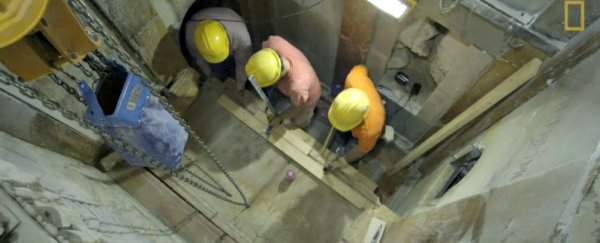Archaeologists in Jerusalem say they've discovered evidence of the original stone tomb where Christian tradition says Jesus' body was laid following his crucifixion.
The innermost chamber at the centre of Jerusalem's Church of the Holy Sepulchre has long been considered by many historians and Christianity as the site where Jesus was entombed and eventually resurrected, but until now it was assumed that the original cave chamber had been destroyed over the years.
But, using ground penetrating radar tests, archaeologists have spotted evidence of hidden layers behind the marble chamber, and they think they could be the stone walls of the original cave, standing up to 1.8 metres (6 feet) tall. They're now in the process of excavating the marble and attempting to expose the original stone.
"What was found is astonishing," National Geographic Society archaeologist Fredrik Hiebert told Daniel Estrin from the Associated Press. "I usually spend my time in Tut's tomb," added Hiebert, who works in Egypt, "but this is more important."
The hidden layers were stumbled upon during a restoration project between the National Geographic Society and the National Technical University of Athens in Greece, which aimed to preserve the Church of the Holy Sepulchre's Edicule - the internal chamber that houses the cave where Jesus is said to have originally been entombed and resurrected.
Built in the 12th century, the Church of the Holy Sepulchre is one of Christianity's oldest and most important churches, and the only place where all six Christian denominations choose to worship.
According to Christian tradition, it's on this site that the body of Jesus Christ was laid on a shelf chiselled out of the side of a limestone cave following his crucifixion somewhere between 30 and 33 AD.
Christians believe that Jesus was resurrected after death, because the women who came to anoint his body three days after his burial found no remains.
The location of this cave remained unclear until the site where the church now stands was identified in 326 AD by Helena, the mother of the Roman emperor Constantine, and since then it's remained a holy spot.
The burial shelf is now enclosed in the small marble Edicule chamber within the church, and archaeologists were working on restoring it for the first time since 1810 when they detected the radar evidence of hidden walls behind the marble.
They archaeologists are now in the process of excavating the site further, and have so far removed the main marble slab for the first time since 1550, uncovering a whole lot of rubble below it.
After removing this debris, they found a second marble covering, which they think is covering the original cave wall.
"The marble covering of the tomb has been pulled back, and we were surprised by the amount of fill material beneath it," Hiebert told National Geographic. "It will be a long scientific analysis, but we will finally be able to see the original rock surface on which, according to tradition, the body of Christ was laid."
If the team is able to expose the original burial bed, it'll give them the chance to study the surface that Christian tradition says Jesus' body was laid upon, and with further analysis they might be able to find out more about the history of the site, and the real events that inspired the stories.
Hopefully they'll also be able to put out some peer-reviewed research on the site - for now, we're just taking the archaeologists' words for what's been found.
The only problem is that Christian communities have only given the archaeologists 60 hours to excavate the inner sanctum, and they're working day and night to reach the original cave.
Afterwards, the team will seal up the tomb, but leave a window in the marble walls so visitors to the church can glimpse the cave wall.
"We will close the tomb after we document it," Antonia Moropoulou from the National Technical University of Athens told AP.
It's not year clear what the team will find behind the next layer of marble, but the fact that they've found these hidden layers is pretty exciting.
David Grenier, secretary of a group that oversees Roman Catholic church properties in the Holy Land, told AP, "What happened here 2,000 years ago completely changed the history of the world."
"To be able to dig, let's say, to the rock where the body of Jesus was laid … it's overwhelming joy."
We're looking forward to seeing what the team finds.
